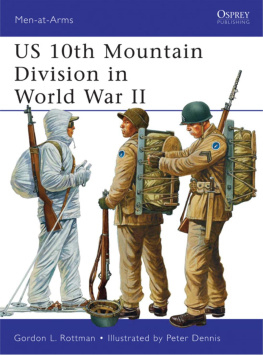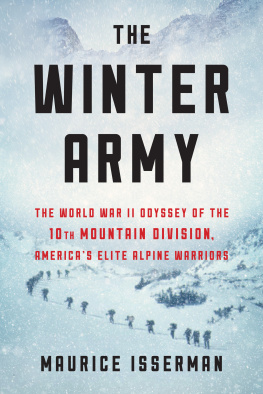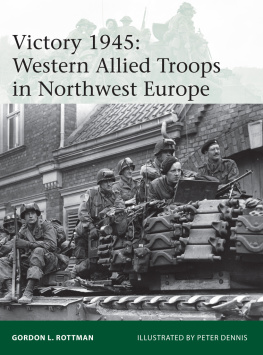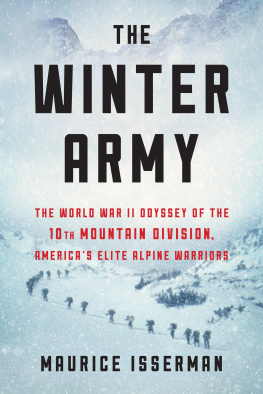B ehind the L ines
A Soldier, His Family, and the
10th Mountain Division
Mary Donaldson-Evans
Austin Macauley Publishers
2021-05-28
Behind the Lines
About the Author
During a career at the University of Delaware as the Elias Ahuja Professor of French and a specialist of 19th-century French literature and culture, Mary Donaldson-Evans published several books, including Medical Examinations and Madame Bovary at the Movies. Following her retirement, she reinvented herself as the author of memoirs and short fiction. Her creative works have been published by The Lowestoft Chronicle, The Literary Hatchet, Boomer Lit Magazine and others. Inspired by the discovery of a trove of letters exchanged by her parents during World War II, Behind the Lines is her first book-length non-academic project.
Dedication
This book is dedicated to the memory of my parents, Lawrence and Lillian Prudhomme, and to the great-grandchildren they never knew: Sophie, Tristan, and Naomi.
Copyright Information
Mary Donaldson-Evans (2021)
The right of Mary Donaldson-Evans to be identified as author of this work has been asserted by the author in accordance with section 77 and 78 of the Copyright, Designs and Patents Act 1988.
All rights reserved. No part of this publication may be reproduced, stored in a retrieval system, or transmitted in any form or by any means, electronic, mechanical, photocopying, recording, or otherwise, without the prior permission of the publishers.
Any person who commits any unauthorised act in relation to this publication may be liable to criminal prosecution and civil claims for damages.
All of the events in this memoir are true to the best of authors memory. The views expressed in this memoir are solely those of the author.
A CIP catalogue record for this title is available from the British Library.
ISBN 9781528954563 (Paperback)
ISBN 9781528954808 (ePub e-book)
www.austinmacauley.com
First Published (2021)
Austin Macauley Publishers Ltd
25 Canada Square
Canary Wharf
London
E14 5LQ
Acknowledgement
This project would never have come to fruition were it not for the assistance Ive received from friends and family alike. My gratitude to my husband, Lance, is nearly impossible to put into words; he never lost faith in the book, even when my own will to proceed faltered; he signed us up for a Hill Towns Tour of Italy that was sponsored by the Descendants Organization of the 10th Mountain Division and led by Steve Coffey, Don Perkins and Val Rios; and he managed to locate my dads Italian family. Others who read the entire manuscript and offered helpful advice and/or encouragement were my children, Catherine and Andrew; my daughter-in-law Kristin; my brother Chuck and his wife, Gail; my friend Joyce Acton; my lifelong soul sisters Margaret Kinetz and Susie Johnson; Senator Bob Dole through the intermediary of his counsel Marion Watkins. My son Andrew also helped design the cover, while my daughter Catherine, an experienced journalist, provided an initial edit of the entire manuscript. In addition, she put me in touch with Raquel Avila who shared her publishing expertise with me and led me to Austin Macauley. Karen Orman read an early chapter and offered encouragement. Scott Carpenter also read part of the manuscript, and his candid comments shaped my project. Bob Mitchell helped me develop a book proposal, and along with Siobhan Adcock, Concha Alborg, Jan-Erik Guerth, John Hurt, and Richard Zipser offered publishing advice. Annie Hasselhan and Barbara Cooper forwarded articles of interest, and Barbara was a constant cheerleader who helped me stay focused. My son-in-law, Brandon Strawder, likewise, kept me motivated by the interest he took in the book and his frequent probing questions. Ann Fernandez provided much-needed tech support. People affiliated with the Descendants Organization of the 10th Mountain Divisionamong them Barbara Catterall, Rosario Salemi, and Sepp Scanlin, Curator of the 10th Mountain Division at Fort Drumwere helpful in myriad ways. Felicity Halloran, editor of Blizzard, the 10th Mountain Division publication, made space for me in the pages of that publication. Keli Schmid, curator of the 10th Mountain Division collection at the Denver Public Library, provided me with relevant documents and answered my numerous questions with alacrity and good-natured patience. Austin Macauleys Cheryl Jones was likewise responsive to my queries. Publishing coordinator to Vinh Tran, she became for me a veritable lifeline to the company. Finally, the wonderful Schiratti family of Italymost notably Claudio, Laura, Franca, and Louisahappily became part of my project, the first three by digging into their memory banks to answer questions about the war and the family as they were when my father knew them, the last by orchestrating the encounter that would bring me face-to-face with the family. The two little Schiratti girls who so enthralled my father in 1945, now women of my age, have become my friends.
Space does not allow me to thank by name the many other friends and relatives who, although not directly involved in this project, have by their support and their appreciation of my post-retirement stories and memoirs made me believe in myself. They know who they are.
Prologue
June 11, 2017. It is a blistering hot day, the kind of day that makes me long for the refreshing water of a swimming pool. On a normal summer day like this Id be swimming laps at Hidden Hollow Swim Club in Media, Pennsylvania.
But here I am, outside of Florence, Italy, at the American Cemetery and Memorial, with about one hundred other people, perspiration beading on our foreheads, suffering in solemn silence as we waitthe lucky ones in a patch of shadefor the ceremony to begin. We are descendants of soldiers of the 10th Mountain Division, Americas first alpine division and the unit that helped turn the tide of the Second World War in Italy and forced the German surrender on May 2, 1945.
We have come to the cemetery by bus, rolling through gentle Tuscan hills, past yellow fields, vineyards, olive groves, cypress trees, salmon-coloured stucco homes with tiled roofs. Its a lovely countryside, so peaceful that it seems strange to believe that these hills once set the stage for the brutalities of war.
At one end of the cemetery stands the pavilion, with a representation of battle maps, crests of the various divisions that fought in Italy, and a large panel containing the engraved names of soldiers missing in action. Many were only boys, 18 and 19 years-old, and they gave their lives to defeat the Nazis. A statue at the front of the pavilion symbolises the spirit of peace. Looking out over the graves of the fallen, it holds olive branches aloft.
I raise my gaze to look at the long rows of dazzling white marble crosses and Stars of David fanning out from the memorial in a sea of meticulously tended green grass. 4,398 soldiers are buried here, young men who lost their lives in the defence of freedom. Tears sting my eyes as I contemplate their sacrifice and quietly mourn the passing of that heroic epoch when the United States played a pivotal role in defeating the evil of Nazi Germany.
Im here for you, Dad.
To the right of the pavilion, down a few steps, I notice that folding chairs have been set up under a tent, offering some relief from the scalding heat. I take my place.







